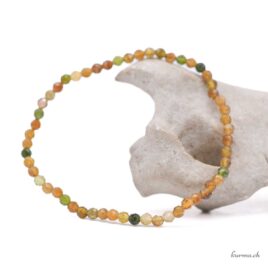La Dravite - Brown tourmaline
gemstones in bracelets and pendants
Dravite is a variety of brown tourmaline. Its name comes from the Drava, an Austrian river where it was officially discovered.
In lithotherapy, it is a powerful anchoring stone.
What are the properties and virtues of brown tourmaline in lithotherapy?
Dravite is a semi-precious stone strongly linked to anchoring and stability: its hold on the Earth is the key to supporting the growth of our inner strength and Its protective power has made it a sought-after talisman in many civilizations.
The origins of brown tourmaline
Dravite was discovered and identified as a brown tourmaline on the Drava River in 1883 by Austrian mineralogist Gustav Tschermak. However, this modern classification does not mean that this fine stone was not known in antiquity. In fact, it can be found on every continent, in places as varied as Sri Lanka, Brazil, Russia and Australia - and many others.
As a result, its mystical healing and protective properties have endured through the ages.
In India, Dravite was considered a spiritual anchor stone. By balancing the chakras, it can enhance meditation and peace of mind.
The ancient Egyptians also used it as an amulet for its healing and protective properties.
In ancient Greece, it promoted emotional balance by helping to overcome fears and anxieties.
Lithotherapy properties
It is through a deep connection with nature and the natural cycles of life that the movements of the spirit and their beneficial evolution are possible. Paradoxically, this relationship with fluidity relies on an anchoring that will be the foundation and a trough for growth. Stability makes movement possible, from earth to sky and light.
In lithotherapy, Brown Tourmaline is known for its Earth-related properties, which promote nourishment for the strength of the spirit.
This makes it a wonderful anchoring stone that re-establishes our connection with Mother Earth. You can also explore all our brown and maroon crystals on the page dedicated to our minerals and jewelry in these colors.
Dravite helps us to preserve or regain a sense of responsibility, as well as a good awareness of the concrete reality of existence. It inspires a more structured and orderly and stable life, and helps us break bad habits.
It helps to make peace with the past. It can be a great healer of transgenerational wounds and repetitive family patterns.
By supporting self-acceptance, it encourages the elimination and sublimation of negative energies, relaxation and meditation.
Action on the body
Brown Tourmaline is also renowned for its relaxing effects on the body in lithotherapy.
It is ideal for tension or blockages in the lower body: feet, legs and knees.
Its high magnesium content helps the body regenerate after a heavy meal, a night of drinking or a lack of sleep. It's the anti-hangover stone of choice for partygoers.
Its symbol can be beneficial for the digestive system, helping to soothe irritable bowel syndrome.
How to use brown tourmaline
Essentially linked to the root chakra, located at the base of the spine, working with this stone on this part of the body can reinforce your sense of security. It can also nourish the heart and solar plexus chakras, balancing emotions and strengthening willpower.
Dravite can also accompany you as a talisman placed close to you or in your pocket, or as jewelry, as a pendant necklace or bracelet, for its beauty and protective virtues.
Which crystals enhance the beneficial effects of Dravite in lithotherapy?
- Combined with Amethyst for emotional balance
- with Citrine, for greater clarity and motivation
- associated with Hematite, it amplifies its anchoring and stability.
- Labradorite, for the insight needed for transformation
- Obsidian, to overcome blockages and release energy
- with Black Tourmaline for added protection.
Purification of brown Tourmaline
Reloading / cleaning
Sun/Moon, earth, fumigation, running water, breath, intention, singing bowl, form waves, prayers...Astrological signs
Capricorn - and for all those born in winterChakras
1st Chakra - RootCan influence the heart chakra and solar plexus chakra
Element
EarthDravite mineralogy
Dravite, or brown tourmaline, belongs to the tourmaline group of minerals.
Its complex chemical composition consists of sodium and magnesium borosilicate.
It forms primarily in metamorphic rocks and granitic pegmatites.
It is present in the Americas in Brazil and the United States, in Tanzania and Madagascar in Africa, in Austria, Slovenia and Italy in Europe, as well as in Sri Lanka, Russia and Australia.
Dravite has a hardness of 7 to 7.5 on the Mohs scale - so it's fairly resistant to wear and abrasion.
Lithotherapy
Mineralogy
- Hardness :
- 7.0
- Moths scale:
- 7
- Strunz classification :
- Silicate
- Crystalline system :
- Trigonal
- Chemical element :
- Na, Mg, Al, B, O, Si, H
- Line color :
- Light brown, rarely white
- Density :
- 3.03 to 3.18 g/cm³ (measured); 3.038 g/cm³ (calculated)
- Cleavage :
- Poor - very poor {1120}
- Fracture:
- Irregular, uneven, conchoidal
- Transparency :
- Transparent to translucent
- Refringence :
- nω = 1.634 to 1.661, nε = 1.612 to 1.632
- Birefringence :
- Uniaxial (-); δ = 0.022 to 0.029
- Pleochroism :
- Fort
- Colors :
- Light to dark brown, blackish, more rarely dark yellow or blue
*Please note! Some minerals may be toxic and must not be licked or ingested (as such or in the form of powder, elixir or stone water) or be in prolonged contact with the skin or mucous membranes.
*The information on the stones described here are general indications based on our research and experience, and are not exhaustive.
Reproduction in whole or in part of this content is prohibited. More info


